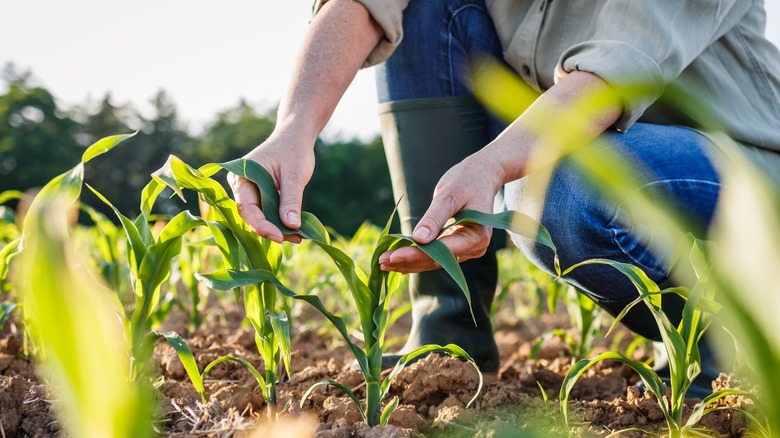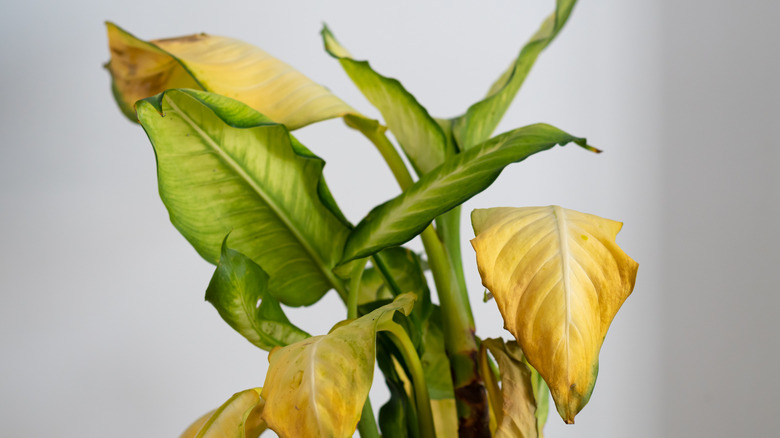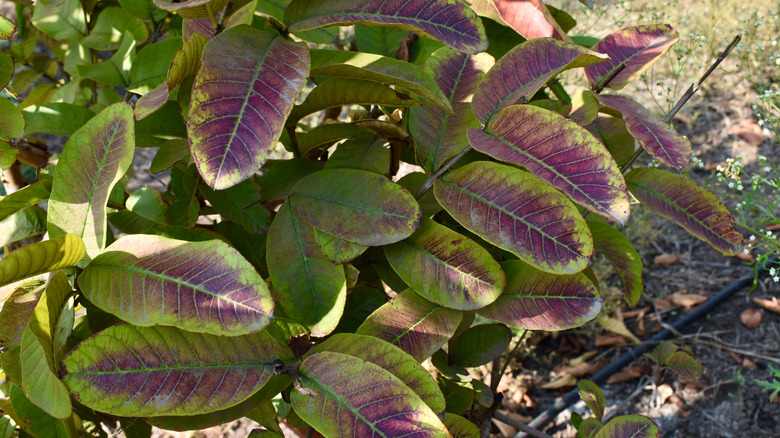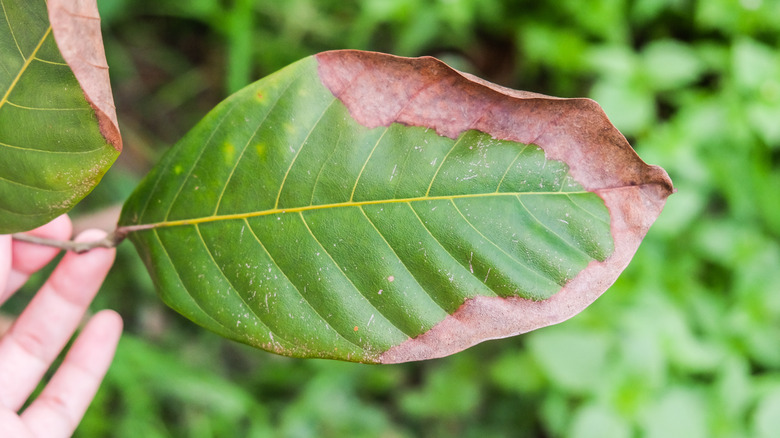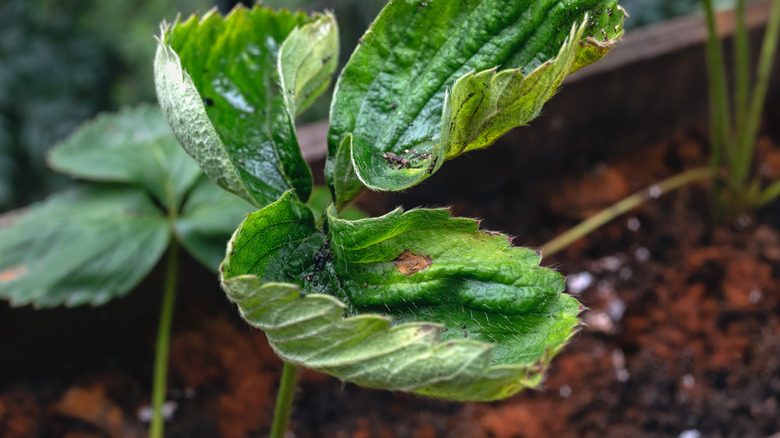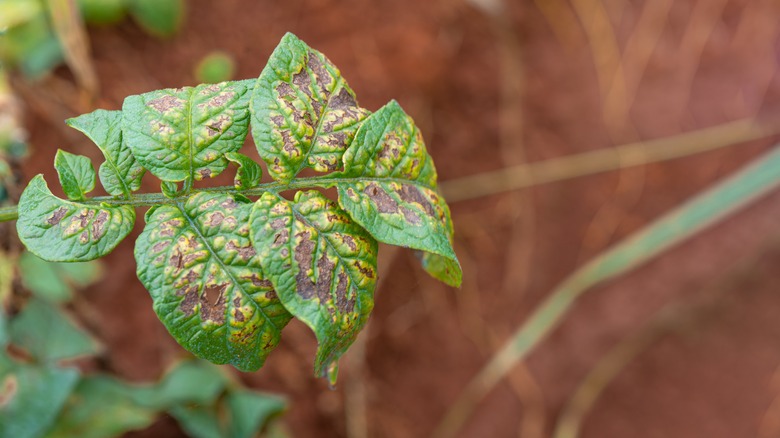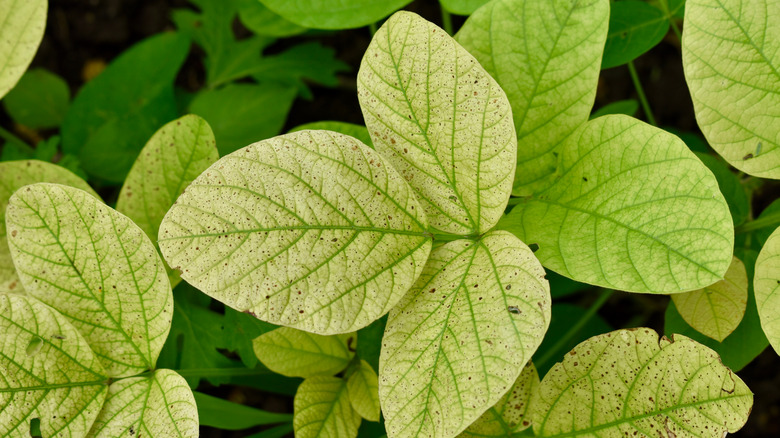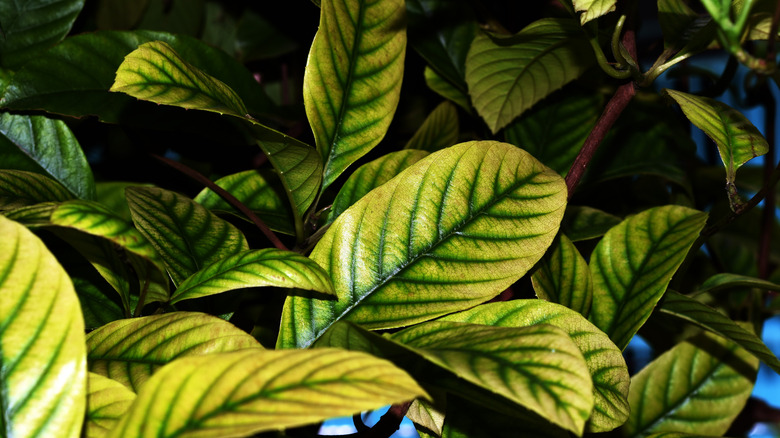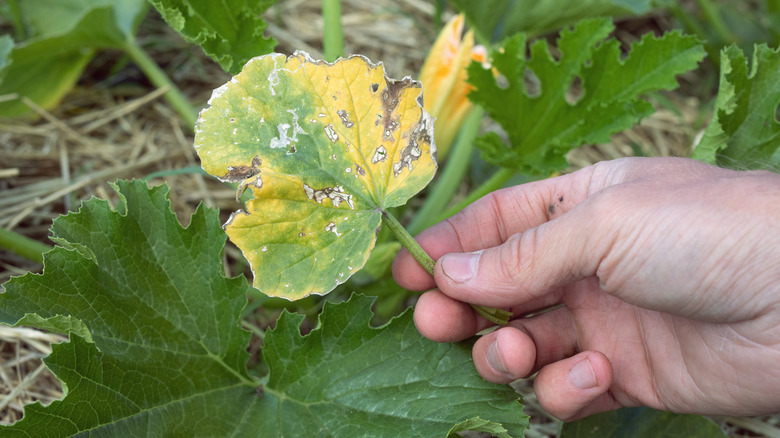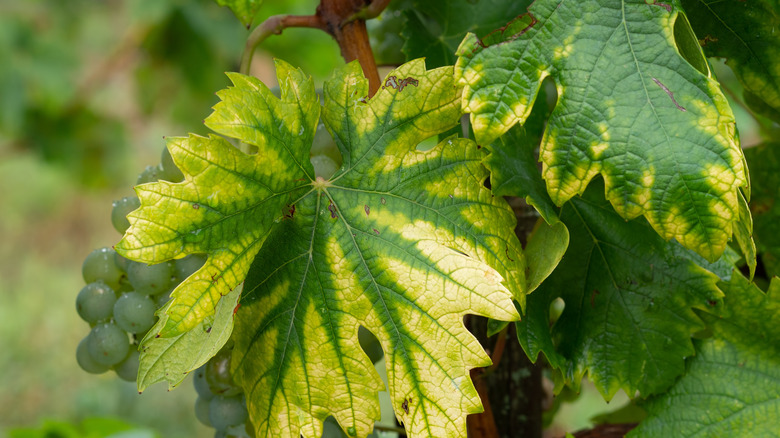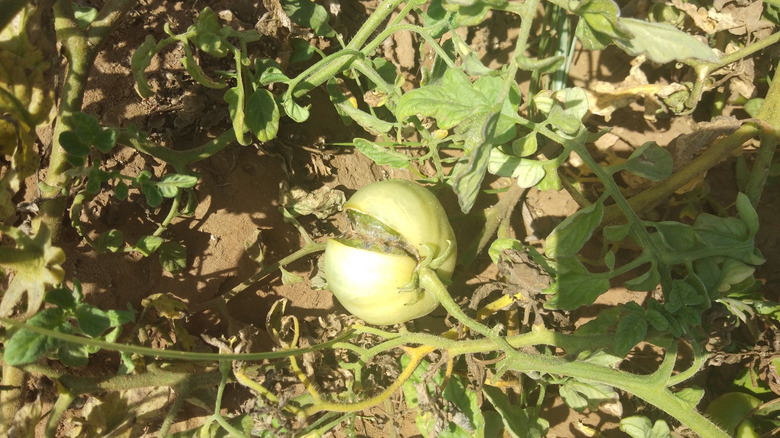How To Identify And Treat Nutrient Deficiencies In Plants Like A Gardening Pro
We may receive a commission on purchases made from links.
Sometimes, despite your best efforts as a gardener, your plants might still appear to be suffering from nutrient deficiencies. Each plant has its own way of indicating distress. Information from Iowa State University shows that discoloration of leaves, stunted growth, and unusual leaf shapes are common signs. Correctly identifying the symptoms is vital because each type of deficiency demands a specific solution. Furthermore, keep in mind that one of the main reasons plants struggle to get enough of these nutrients is that they can't move to find them, as revealed in a 2013 study published in the journal Nature Education. The study also highlights that different plants have varying nutrient requirements. For instance, what benefits a flowering plant may not suit a vegetable crop. You'll need to tailor your nutrient strategy to each plant's needs, and this involves more than just applying fertilizers; it's also about providing the right nutrients in appropriate amounts. Both over- and under-fertilization can adversely affect plant health.
When managing nutrient deficiencies, it helps to be aware that too many nutrients can be bad. Furthermore, some types of plants are more prone to certain deficiencies. Leafy greens and some flowers, for example, might need more nitrogen, while root vegetables often require extra phosphorus or potassium. On the other hand, fruit-bearing plants have higher demands during the flowering and fruiting stages. Understanding these specific needs helps you not only address current deficiencies but also prevent future problems.
Yellow lower leaves and green top leaves
If you've noticed some plants turning yellow on their lower leaves while their tops remain a vibrant green, this is a common sign of nitrogen deficiency. According to the University of Missouri Extension, nitrogen is a fundamental element in chlorophyll, the compound that gives plants their green color and is essential for photosynthesis. It's also a key component in amino acids, the building blocks of proteins necessary for plant growth. The yellowing of lower leaves happens because nitrogen is a mobile nutrient within the plant, as revealed in an article by Dr. John Sawyer at Iowa State University. When nitrogen is scarce, the plant prioritizes its supply for new growth, thus withdrawing it from older leaves. This process results in the older, lower leaves losing their green hue and turning yellow.
Several factors can lead to low nitrogen levels in plants. These include having soil that's either too old or constantly waterlogged. Sometimes, if the soil gets too dry, particularly mid-season, that can also cause a problem. To correct this deficiency, you need to apply a nitrogen fertilizer to introduce more nitrogen into the soil. You can opt for organic options like fish emulsion or blood meal. For a more immediate solution, you can also use synthetic nitrogen fertilizers. However, it's important to apply these carefully, as excess nitrogen can lead to rapid growth at the expense of flowers and fruit.
Dark green, purply leaves on older plants
Phosphorous helps with plant development, particularly in root growth, flower and fruit production, and energy transfer. When plants don't get enough phosphorus, they usually don't grow as much and might look unusually dark green. Also, they can build up sugars, which lead to the development of anthocyanin pigments, giving the leaves a reddish-purple color. This change in color is a common sign of phosphorus deficiency. Phosphorus is also important for the energy processes within the plant. It's integral to the formation of ATP, the energy currency of cells. In its absence, plants struggle to maintain normal growth processes, leading to the observed symptoms. Older leaves are typically affected first as the plant redirects its limited phosphorus supply to new growth.
To address this deficiency, add phosphorus-rich fertilizers. Again, you can choose bone meal or rock phosphate, which slowly releases phosphorus into the soil, providing a long-term solution to the deficiency. In addition to applying fertilizer, try to maintain the correct soil pH for proper phosphorus uptake. Most plants absorb phosphorus best in a slightly acidic to neutral pH range. If your soil is too alkaline or too acidic, it can inhibit phosphorus availability, regardless of how much is present in the soil. It's good practice to regularly test the soil and monitor pH levels and nutrient content.
Burnt appearance of leaf edges
Potassium plays a vital role in various plant processes. It's often defined as a macronutrient, and a deficiency can lead to several noticeable symptoms, with the most prominent being the scorched appearance of leaf edges. The color of the edges can appear dark and curled up, a big sign that the plant is struggling to regulate its water content. This can lead to dehydration symptoms. Additionally, potassium is integral to the activation of enzymes necessary for photosynthesis and other metabolic processes. Without sufficient potassium, these processes are hindered, affecting overall plant health and growth.
You can address a potassium deficiency by introducing potassium-rich fertilizers like Sulfate of Potash. This type of fertilizer contains potassium and sulfur, two essentials. Its chemical formula is K2SO4. Unlike some other potassium fertilizers, like potassium chloride, Sulfate of Potash doesn't contain chloride, which can be harmful to some plants. This makes it a preferred choice for chloride-sensitive crops. It's important to apply fertilizer judiciously and as instructed by the manufacturer. Over-application may lead to an imbalance of other nutrients, particularly nitrogen and phosphorus. Additionally, soil texture and structure can impact potassium availability. For instance, sandy soils can leach potassium more quickly than clay soils.
Stunted growth of new leaves
Spotting stunted growth in the new leaves of your plants often points to a calcium deficiency. This nutrient, though less talked about than nitrogen or potassium, plays a pivotal role in the overall health and development of plants. According to a 2003 study published in the journal Annals of Botany, calcium is crucial for cell wall structure, providing stability and strength to plant tissues. It's also essential for enzyme activity and signaling processes within the plant. One unique aspect of calcium is its immobility in plants. Unlike nitrogen, a plant cannot redistribute calcium from older leaves to new growth. This characteristic makes new growth more susceptible to calcium deficiency symptoms. In some cases, you might also observe blossom end rot in fruits – particularly tomatoes and peppers — which is another sign of calcium shortage.
To correct calcium deficiency in soil, mix in some round limestone, which provides a dual benefit of supplying calcium and adjusting soil pH toward neutrality, enhancing nutrient availability. Another option is gypsum, which supplies calcium without altering soil pH. In addition to soil amendments, consistent watering plays a critical role in calcium uptake. According to a 2011 study published in the Journal of Experimental Botany, calcium is transported in plants through water. So, irregular watering can lead to fluctuations in calcium levels within the plant, exacerbating deficiency symptoms. It's also worth noting that excessive levels of other nutrients, particularly potassium, can interfere with calcium absorption. You'll need to balance these nutrients to prevent competition at the root level.
Insufficient chlorophyll production between veins of older leaves
When your plants' older leaves start showing a distinct yellowing between the veins while the veins stay green, it's a clear call to action against magnesium deficiency. Magnesium is another nutrient at the heart of chlorophyll production, which gives leaves their green color and is essential for photosynthesis. But magnesium's role isn't limited to just being part of chlorophyll. It also activates many plant enzymes, crucial for growth and development, and is involved in DNA and RNA synthesis, vital for cell division, per a 2021 study published in the International Journal of Molecular Sciences. When magnesium is low, plants exhibit reduced photosynthesis efficiency, leading to the yellowing of older leaves, a condition known as interveinal chlorosis.
To tackle this, start with applying Epsom salts (magnesium sulfate), an effective and easily absorbed magnesium source. You can use it as a soil amendment and a foliar spray. Remember, it's not just about adding magnesium; it's about maintaining the right balance. Other nutrients, especially potassium, can interfere with magnesium uptake, so keep an eye on the overall nutrient balance.
Pale to deep yellow coloring on the surface of newer leaves
When newer leaves in your garden begin to exhibit a pale to deep yellow color, it's a signal that your plants might be suffering from a sulfur deficiency. Often overlooked, sulfur is a vital nutrient essential for the production of proteins, enzymes, and vitamins. This deficiency can significantly impact the plant's growth and vitality, and manifests differently from other nutrient shortages. Usually, you'll see the symptoms first on the younger leaves, and these signs stick around even if you add nitrogen. But in plants like tobacco, it's interesting because some of the leaves that are older are the first to show signs of sulfur deficiency.
When addressing this issue, the simplest solution is to add some sulfur. You can use a magnesium-containing fertilizer like Epsom salts or kieserite. If you prefer organic gardening, try a composted mushroom fertilizer. Alternatively, you could also explore using gypsum, which is another effective way to add sulfur, especially for soil health. For a more targeted approach, foliar sprays with sulfur can directly address the deficiency in the plants. Remember, the key is to choose a method that fits well with your gardening style and your plants' specific needs. Another aspect to consider is the role of organic matter in sulfur availability. Organic fertilizers and amendments, like compost and manure, can gradually release sulfur and other nutrients into the soil. This slow release provides a steady supply of sulfur that plants can utilize over time.
Yellow leaves and green veins on newer leaves
Zinc, though required in small amounts, is a critical trace element for plants. It plays a significant role in various plant functions, including hormone production, enzyme activation, and protein synthesis. Without adequate zinc, your plants may exhibit stunted growth, distorted leaves, and the distinct symptom of yellowing leaves with green veins. Zinc deficiency often occurs in areas with high soil pH, overly sandy soils, or in soils with high phosphorus levels. It can also be a problem in cool, wet soils where zinc becomes less available to plants.
To combat this deficiency, you need to supply your plants with a readily available form of zinc. Apply a zinc sulfate product (that contains about 35% zinc) as a soil amendment. You can spread this material across the soil and mix it in before planting, or you can use it as a starter fertilizer. As with sulfur, you can also use a foliar spray, which allows the plants to absorb zinc directly through their leaves, providing a quicker response. It's important to apply zinc carefully. Being a trace element, plants need it in very small amounts. Excessive zinc can be toxic to plants and can interfere with the uptake of other essential nutrients. The key is to apply just enough to correct the deficiency without overdoing it.
Stunted look of newer leaves with necrosis spots
Your plants might be facing a copper deficiency if there is stunted growth in the younger leaves along with spots of necrosis (dead tissue). Copper is a micronutrient that, though only needed in small quantities, plays a vital role in plant health. It's integral to seed and chlorophyll production, and the strengthening of plant cell walls. Copper also plays a part in the formation of lignin, which is crucial for supporting plant structure. Copper deficiency is more common in sandy soils, as they tend to have lower organic matter content and can leach nutrients quickly. It's also frequently seen in heavily amended soils where high levels of other nutrients, particularly nitrogen and phosphorus, can inhibit copper absorption. The challenge with copper is that it's needed in very small amounts, and the line between deficiency and toxicity is thin.
To correct a copper deficiency, you can apply copper-based fertilizers. A commonly used product is copper sulfate, often found under brand names like Bonide Copper Fungicide or Southern Ag Liquid Copper Fungicide. When using copper sulfate, it's essential to adhere to the recommended application rates. Copper, being a heavy metal, tends to build up in the soil, and too much can damage both your plants and the surrounding soil ecosystem. It's a balancing act to provide enough copper for plant health without causing harm.
Pale yellow newer leaves with dark veins
Newer leaves turning a pale yellow while their veins remain dark, is a classic symptom of iron deficiency. Iron is a crucial micronutrient for plants, primarily responsible for the synthesis of chlorophyll, which gives leaves their green color. It's also vital for several enzymatic functions and energy transfer within the plant. Iron deficiency, commonly known as chlorosis, can significantly impact the plant's photosynthesis process and overall health. Due to its scarcity or the plant roots' inability to absorb it, iron deficiency frequently affects plants. This can be due to overly wet conditions or compacted soils, which hinder root growth and reduce the availability of iron. Additionally, in some cases, high levels of other minerals like manganese can interfere with iron absorption.
To address iron deficiency, applying a chelated iron fertilizer is often the most effective solution. Chelated iron is a form of iron that's been bound to an organic compound, making it more readily available for plant absorption. You can apply it directly to the soil or use as a foliar spray for quicker uptake by the plants. While addressing the iron deficiency, it's also important to consider the root environment of your plants. Ensuring good drainage and avoiding waterlogged conditions can help improve iron uptake. Moreover, loosening compacted soils can enhance root growth and nutrient absorption, including iron.
Deformed plant growth
Deformed plant growth in your garden might point toward a boron deficiency. While boron is needed in trace amounts, it's crucial for cell wall formation and is integral to the movement of sugars and the development of reproductive structures in plants. A lack of boron can lead to a range of growth abnormalities, including stunted growth and poor fruit or flower quality. Boron deficiency often arises in soils that are excessively leached or in regions with heavy rainfall, which can wash boron away from the soil. The deficiency symptoms might be more pronounced during periods of rapid growth when the demand for boron is higher. Additionally, certain plants are more susceptible to boron deficiency, including root crops like beets and carrots and brassica crops like broccoli and cauliflower.
To counteract the deficiency, the application of boron supplements like Borax can help. However, as with any micronutrient, the key is moderation. You'll need to apply approximately 35 grams per 20 square meter. Boron toxicity can occur if you apply too much, and the margin between deficiency and toxicity is narrow. Therefore, only apply small amounts, as directed by the product guidelines. When applying boron, distribute it evenly across the soil. Boron is not mobile in plants, so it needs to be available uniformly in the root zone to be effective.
